Silicon Dreams: An Interview with Doug Menuez
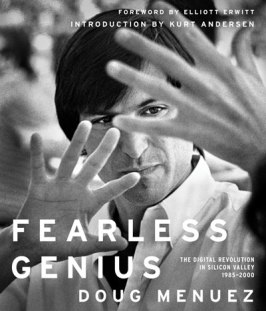 In the last thirty years, digital technology has become indispensable. So seamlessly is this technology integrated into our lives that it’s sometimes hard to remember that as recently as the mid-Eighties there was no World Wide Web, no Instagram or Netflix. Facebook wasn’t even a gleam in the eye of Mark Zuckerberg, who was gumming teething biscuits (and maybe rating his babysitters’ looks) at the time.
In the last thirty years, digital technology has become indispensable. So seamlessly is this technology integrated into our lives that it’s sometimes hard to remember that as recently as the mid-Eighties there was no World Wide Web, no Instagram or Netflix. Facebook wasn’t even a gleam in the eye of Mark Zuckerberg, who was gumming teething biscuits (and maybe rating his babysitters’ looks) at the time.
The incredible speed at which this technology developed—creating more jobs in the U.S. than at any other time in history—is due to a group of young visionaries who happened to congregate in Silicon Valley at a moment of intense idealism. These entrepreneurs—among them Steve Jobs, Bill Gates, Marc Andreeson and Bill Joy—took the Valley over, infusing it with energy and possibility. History was on their side: they were in the right place at the right time.
Doug Menuez was right there too. A young Bay Area photojournalist, he had just returned from a brutal assignment photographing the Ethiopian famine in 1985, and was burned out from years of covering the AIDS crisis, homelessness and the drug wars. Determined to find a more uplifting story, he found his attention piqued when Steve Jobs announced that his new venture, the NeXT computer, was going to revolutionize education. “I’d seen from my work how important education was in Brazil, in Africa, in China, in East Oakland,” Menuez says. “If Steve Jobs—who’d already changed the world—was going to put his mind to that, it got my attention and made me very, very interested in technology and the people building it.”
What followed was a fifteen-year project that took Menuez to over seventy Silicon Valley companies. Photographing in gritty black-and-white documentary style, he captured the triumphs and disappointments, the inspirational meetings and the 3 a.m. boxes of Chinese takeout. He saw workers from nearby Pueblo tribes making silicon chips, and observed the influence of women leaders in creating the software that would shape our lives.
Menuez’s new book, Fearless Genius: The Digital Revolution in Silicon Valley 1985-2000 , tells the story of these transformative years. Beginning with Steve Jobs reinventing himself after he was forced out of Apple, it goes on to document Silicon Valley in the fifteen years before the dot-com crash. The images convey the intense creativity and idealism of the time, and, in an attempt to inspire the next generation of tech innovators, Menuez has been taking a slideshow to college campuses. He is also developing a documentary film around the images, and gave a TEDx talk in Boston that is linked further down in this article.
Recently, Menuez spoke to The Literate Lens about Fearless Genius . The interview took place at his beautiful home and studio in Red Hook, New York.
Literate Lens: First off, how did you get Steve Jobs to agree to the idea of documenting him and his new company, NeXT?
Doug Menuez: I knew people who knew Steve, so I reached out to him through them. I was looking for a long-term story. Steve had been forced out of Apple the same year I came back from Africa, and I thought, ‘Wouldn’t it be cool to do a long-term story on inventing this computer and bringing it to market?’ It was a story in my own backyard that I could really sink my teeth into. As photojournalists, we want to improve the world or change the world with a picture—but here were the people who actually were changing the world. Steve understood what I wanted to do, he totally got it. Being Steve, he’d already had this idea. He’d had a filmmaker in there for a brief period. So my timing was perfect.
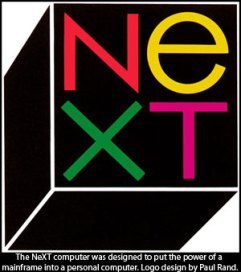 LL: He’d just been pushed out of Apple, so what was his emotional state?
LL: He’d just been pushed out of Apple, so what was his emotional state?
DM: It changed from day to day; sometimes from hour to hour. He’d show up to work energized and happy, and would come bounding in and shoot up the stairs. But at night, after really long days, he could get dark. Sometimes he’d come back from a lunch with some brilliant Silicon Valley leader and would gather people around, trying to explain the ideas and putting it through the ‘Steve brain.’ He’d give us his vision of the future, and listening to those talks was the most electrifying thing that I’ve experienced to this day. But they could sometimes turn into a rant about how NeXT would crush Apple. That was a big theme—to have revenge on his detractors. So yes, he was humiliated. He felt rejected and crushed on a deep level. But he was only in his late twenties, and had endless energy. So ultimately he became very optimistic and positive. He bought a majority interest in Pixar quickly after the beginning of NeXT and sunk millions into that, so he was doing two companies at the same time, which was pretty insane.
LL: You have this great quote in the front of the book, when you asked him what the NeXT cube was all about, and he looked at you intensely and said: ‘I want some kid at Stanford to be able to cure cancer in his dorm room.’
DM: Yes! One day I just casually said, ‘So what the hell are you going to do with this box anyway?’ And he just wheeled on me and said that. What does it mean? It means you’re giving them an operating system and a set of tools that so powerful that they won’t be spending all their time writing code to test their theories, because the code is already there. Maybe it was a metaphor, but he also had this sparkle, a sort of mad gleam in his eye, and I believed he thought it was possible. And why not? They were aiming for the stars. These guys were dreamers—not just Steve, but the whole team. They signed onto that bus to the future. And even though NeXT ultimately failed, its operating system was the basis for the iPhone and iPad, and it fueled Steve’s triumphant return to Apple.
LL: How unusual was he? Were there other Silicon Valley leaders who had the same charisma?
DM: There were a lot who were similar, but what set Steve apart, perhaps, was the willingness to go to the very edge and then leap off the cliff. He was willing to risk everything. He put his money where his mouth was and never gave up on his vision. That can be a recipe for failure, but it’s also the only way to hit it out of the park. He had an amazing ability to focus, and the charisma to recruit a team of the brightest and best in the world. So, I think if you take his passion and drive, and his ability to put a team together, then his knack of withstanding uncertainty and ambiguity and failure, that’s what gives you a guy like Steve who changed so many industries.
LL: Do you feel there’s been a shift in Silicon Valley culture since then? We’ve gone from Steve Jobs curing cancer to Mark Zuckerberg helping us post pictures of our pets.
DM: The people I met in the Valley in the 1980s were really idealistic, they were bringing a humanist, hippie sensibility to a place that had formerly been driven by the Defense Department. And there was a long-term, patient philosophy behind the money being invested at that time. Since the dotcom crash of 2000, when I ended my project, we’ve shifted to more of a money-driven phase. Now, venture capitalists tell young innovators they have eighteen months to create something and make it profitable. So, what’s the innovation mostly around? It’s around apps. You’re not doing breakthrough stuff like solving climate change, because it’s too hard and takes too long. Still, I think it’s a continuum and we’re between these giant waves of technological innovation. I think the idealism is coming back, because there’s a huge new wave of exciting technology coming, and a crop of young innovators who want to create technology that’s not just focused on exploiting our metadata.
LL: You don’t get that innovation without pain. In your TED talk, you emphasized the suffering and the sacrifice that took place during in the early days. Some of your images show people slumped over their computers, exhausted, or fighting. There were some suicides…
DM: Yes, these people are very deeply engaged in what they are doing. One guy went to the psych ward; another committed suicide, and lots of relationships ended.
LL: It was also a period that was notable for having a lot of women in leadership positions. In your TED talk, you suggest that diversity is important because “anyone who writes the code changes the culture.” What did women bring to the table?
DM: It’s hard to generalize between men and women because people vary, but if I were to generalize, I’d say the women were just doing their jobs. They weren’t as ego-driven. They were deeply passionate, working their asses off, and some may have been more political than others but, by and large, it seemed there was less ego at stake. I did observe that when there were meetings with women and people of color included, there’d be more of a tug of war about product features and the products seemed to get better. Whereas the attitude of the some of the men was, “We know what you want.”
LL: In the book’s foreward, Elliott Erwitt talks about how hard it is to photograph something as abstract and intangible as genius. He says you manage to “photograph the unphotographable.” How hard was it?
DM: It’s really not possible, I think. Maybe, in this book I come close to creating a framework for talking about how you’d photograph genius. This is a record of the activities of the time and some of the pictures might give you an emotional truth about the struggle. It was challenging because there wasn’t a lot of physical activity going on: it wasn’t a rodeo, or a war conflict. Occasionally people would be on deadline and rushing around, so I’d grab that activity. At other times, when it was quiet, I started playing around. I’d read faces, look for nuanced detail and think about interesting ways to compose eyes and hands. It started making me think, how do you photograph the creative process? How do you photograph thinking? I don’t know if I accomplished shooting “the unphotographable,” but I think I create a visual toolbox around it that maybe gets you a bit closer.
LL: Did shooting in black and white, on film, make that easier? It was an unconventional choice.
DM: Right. By then, everything was color, so it felt really retro and odd to do black and white. I was lucky enough to get a three year assignment from Peter Howe at LIFE magazine to do this work, and I said to him, ‘You know, why don’t we do it in black and white?’ I grew up with black and white, and I felt it strips away distractions. There’s no mercy. Sometimes color can disguise a weak photo.
LL: Steve Jobs loved the photos, but he killed the LIFE story you’d worked on for three years. What was that about?
DM: When NeXT launched, Steve had eighty magazine covers to choose from. He felt a cover and eight pages in LIFE wasn’t good enough. I was pretty shattered, and one day I caught up with Steve and asked him, ‘What the hell?’ And he said, ‘We just decided LIFE isn’t cool, Doug. Don’t worry about it!’ Then he slapped me on the back and said, ‘These pictures are great! You’re going to have a great time some day with these pictures!’ It was like when he told me about curing cancer: I saw this glimpse of something in his eye, telling me the three years of work I’d just put in wouldn’t be wasted. And he was right! He was prescient about trends and the path things could take; that was one of his gifts.
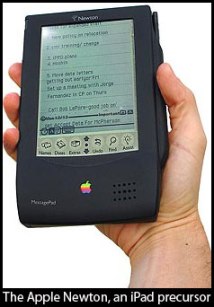 LL: You decided to keep working in Silicon Valley after that…
LL: You decided to keep working in Silicon Valley after that…
DM: Yes, even before the LIFE thing ended, I was interested in what was happening in the Valley. I’d been told about how Photoshop was being developed at Adobe in secret, and I went over there and asked if I could document that. Then someone at Apple told me about the Newton and I asked John Sculley if I could document the Newton team, and he said yes. After that, companies started to commission me. They’d call me up and say, ‘We’ve heard what you’re doing for Steve and we’re doing cool shit too, you should come see what we’re doing.’
LL: What kind of responses do you get from college kids when you show them these images?
DM: Generally speaking, people are surprised. At the TED talk, after I came off stage this young man from Sudan came up with tears in his eyes and embraced me. He was trying to be an entrepreneur and it was inspiring to him. Another guy said, “You know, I go to all these talks about innovation and stuff but you were actually in the room and it gives us a sense of what it was really like.” My audience tends to be more excited the younger they are.
LL: It’s a shift. Did you ever expect to be an inspirational speaker?
DM: Never! It makes me feel like a teacher, and I never thought I’d be a good teacher because I’m too impatient. But I hope I can do more of it, because the reaction is so gratifying, and it could help spur the next generation of innovators. I’ve recently been back in the Valley filming for the documentary we’re making, and I’ve asked a number of people, ‘Is this your burning passion? Is it your desire? Your true love? Are you willing to die for it?’ One young man told me, ‘Oh no, I’m just going to do this, make money, and then go to Bali and figure out the meaning of my life,’ and that was shocking to me, because the thing that first sucked me into this project was the commitment of the people involved. They were like mountain climbers or war photographers, completely willing to sacrifice everything. So yes, I hope this project will reach and touch young people. It’s about the past, but it’s also about where we’re going and how to get there.
—————————————————————-
Doug Menuez’s website is here .
Buy Fearless Genius here .
3 comments on “ Silicon Dreams: An Interview with Doug Menuez ”
Information
This entry was posted on June 30, 2014 by sarahjcoleman in Books , Interviews and tagged Adobe Systems , Apple , Apple Newton , Doug Menuez , Facebook , Fearless Genius , Mark Zuckerberg , NeXT , Photoshop , Silicon Valley , Steve Jobs .Shortlink
https://wp.me/p25Qfq-VlRecent Posts
Archives
Categories
Enter your email address to follow this blog and receive notifications of new posts by email.
Join 11,055 other followers

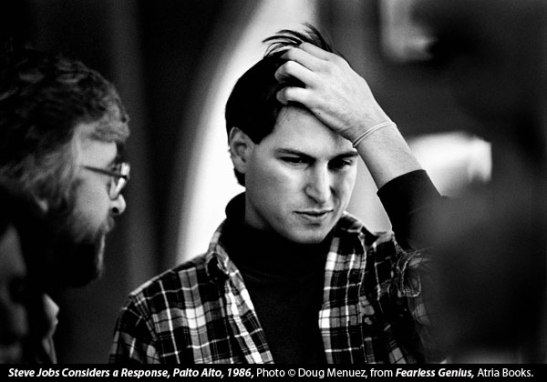
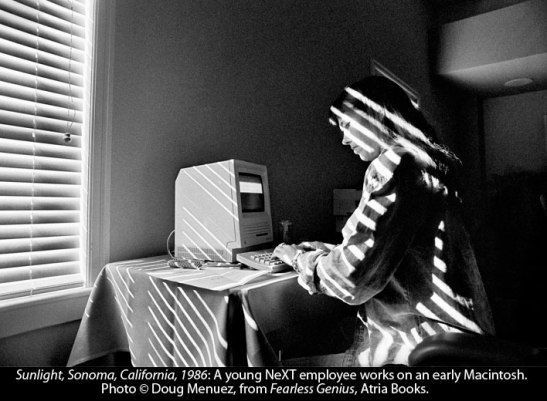
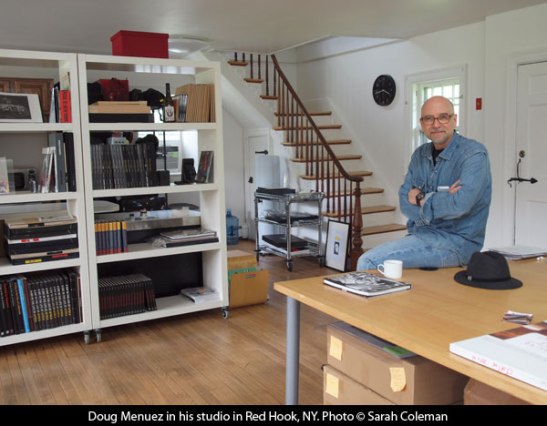
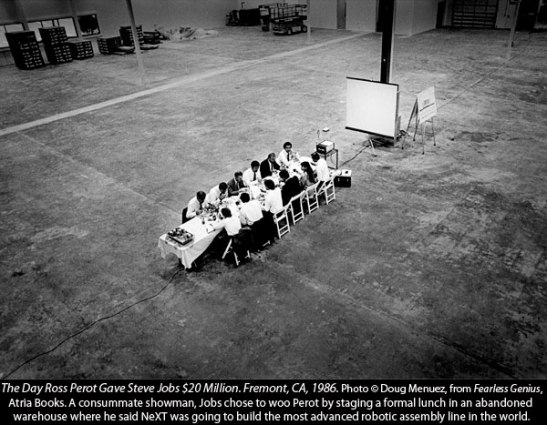
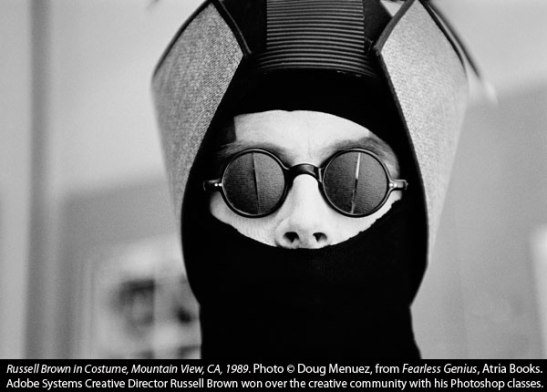
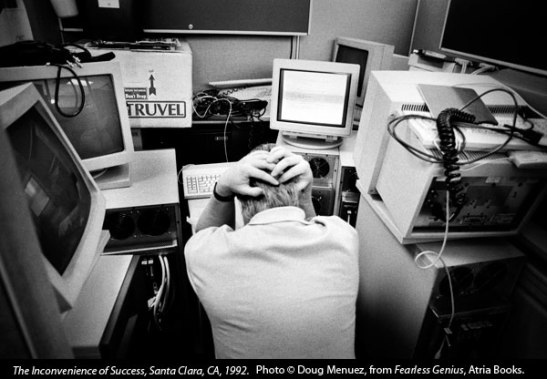
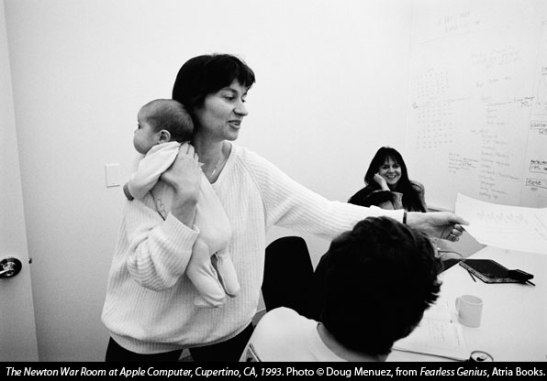
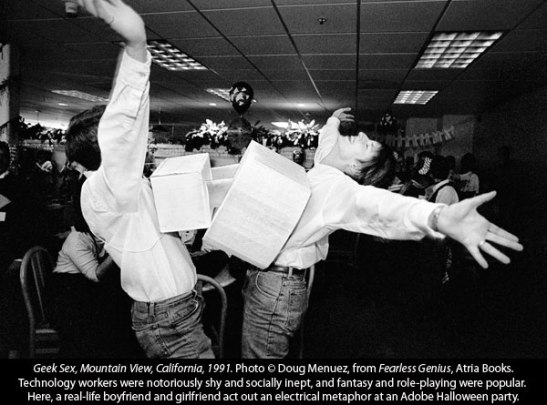

Thank you for this wonderful interview. Living in SF now, in the midst of an “anti-techie” time, I found Mr. Menuez’s comments in the final paragraph very interesting.
I’ll right away seize your rss feed as I can not to find your email
subscription hyperlink or e-newsletter service. Do you’ve
any? Kindly allow me realize in order that I may just subscribe.
Thanks.
Thank you, John. There is a button that allows you to subscribe in the right hand column of every article post, right below ‘Recent Posts.’